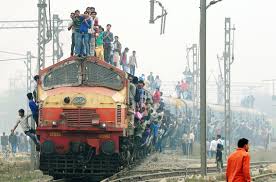Indian Railways-Issues and challenges

Fact Sheet:
India’s railway network caters to about seven billion passenger trips a year. Such humongous infrastructure maintenance possesses extraordinary management challenges.
The foremost challenge of the Indian Railways is that it should be able to ensure that all its journeys end safely.
Death due to human errors despite knowledge of technical glitches in journey of Indian railways can never compensate the loss suffered by the families just by announcements of ex-gratia compensation by the Railway Ministry, the Prime Minister’s Office and State governments.
What ails Indian Railways?
It is carrying 15 times more people than its capacity, and overloading is damaging old tracks. This infrastructure is not getting new adequate investments
Trains do not have adequate and proper safety and fire equipment.
Human errors are the maximum cause of accidents. Yet, proper training is not given.
There are still many unmanned railway crossings which need to be eliminated.
Safety Issues:
According to National Crime Records Bureau, there have been about 30,000 railway accidents a year in recent times and over 25,000 lives have been lost in such accidents.
Indian Railways has recorded an average of 50 derailments a year over the past four years and a peak of 63. Indore Patna Express accident was a big accident that occured after 6 years.
This reinforces the duty of Ministry of Railways to engage in a sustained effort to win back public confidence. More attention needs to be paid to upgrading infrastructure such as tracks and signalling and inducting technologies that help prevent accidents.
The elements of safety — integrity of the tracks, signalling, engines and coaches — need rigorous auditing. Rail fractures are ‘micro cracks’ on rails that develop into ‘major cracks’ following the passage of a train with heavy load. Such accidents can only happen when Ultra Sonic Fault Detection (USFD) checks of tracks are not routinely done.
Internal investigations by the Commissioners of Railway Safety have found human error to be responsible for 70% of serious rail accidents. This shows how much importance has to be accorded to training and adherence to strict operational discipline.
The current train disaster takes into blame- the flaws in the track, the speed at which the late-running train was being driven, and the role played by coach design in leading to high fatalities. These are the few of the core areas which entail modernisation as well as maintenance.
It is not that VIP trains like Rajdhani and Shatabdi are not prone to accidents as they have similar tracks and signalling system. What is different is the quality of rolling stock, namely locomotives, LHB coaches and better monitoring of tracks before such trains pass on them. Hence, railways should be equally vigilant for the non-VIP trains too as it equally carries precious human lives.
Suggestions:
13 million passengers travel in the 7000 passenger trains that are run every day by Indian Railways. These passengers need assurance from Railways that it is learning from its mistakes.
It needs to be overlooked that the high level committee recommendations (Anil Kakodkar on safety and Bibek Debroy on restructuring) are being implemented.
Major reforms like creation of a statutory safety authority, speedy replacement of ageing coaches with modern LHB design and revamped management that keeps its focus on core train operations should be fast tracked.
In Budget 2016-17, the Minister of Railways also announced that all zonal railways would have ultrasound flaw detection machines by March 2017 to test track quality. It should be verified if such a test was done on the Indore-Kanpur-Patna route.
Equally important is the availability of quality medical facilities on the site of accident which improve the chances of survival. Many terrible mishaps occur in rural areas that have no hospital facilities worth the name, no trauma specialists or intensive care. Hence, upgrading district hospitals should be a priority.
Instead of Railway Ministers succumbing to populism and giving priority to announcing new projects and new trains, more focus should be on necessary operational reforms.
Railways is in the process of setting up a non-lapsable fund named Rashtriya Rail Sanraksha Kosh with a corpus of ₹1,19,183 crore for safety improvement. A bulk of that money is proposed to be invested in track renewals and safety works at level crossings.
Also, there is a need to find ideal solution for safety challenges. Various safety aids for preventing collision as well as train protection and warning systems continue to be pilot projects.
Currently, extensive field trials of the anti-collision device (ACD), are going on and once deployed across the zonal railways, this innovative technology will help reduce accidents.
To conclude:
It is true that Indian Railways has monopoly in rail transportation, but it does not mean that it can take passengers for granted. The initial days after accidents will witness public support and anger against railways, but it will be soon lost in committee inquiries and finally forgotten.
This trend has to stop and railways have to be made more accountable. Along with rising fares, the Railways need to provide superior service — better chairs and berths, on-board services and punctuality and safe and secure passage for passengers.
Similarly, safe and secure transportation of goods also needs to be assured for the Railways to attract freight traffic. Mass’s safety and convenience should be priority



Hello blogger ! I read your articles everyday and i must say you have hi quality articles
here. Your website deserves to go viral. You need initial traffic only.
How to go viral fast? Search for: forbesden’s tools